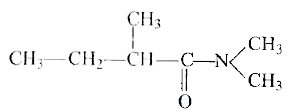Identify
The correct Answer is:C
To solve the question, we need to determine what happens when acetic acid (CH₃COOH) is heated in the presence of phosphorus pentoxide (P₂O₅). Let's break down the steps involved in this reaction.
1. Identify the Reactants:
The reactant given is acetic acid, which has the molecular formula CH₃COOH.
2. Understand the Role of P₂O₅:
Phosphorus pentoxide (P₂O₅) is a strong dehydrating agent. This means that it will remove water (H₂O) from the reactants during the reaction.
3. Write the Reaction:
When two molecules of acetic acid are heated with P₂O₅, the reaction can be represented as:
2CH3COOHΔ→CH3CO−O−COCH3+H2O
Here, the water molecule is removed.
4. Identify the Product:
The product formed from this reaction is acetic anhydride. The structure can be simplified as:
CH3CO−O−COCH3
This can also be written as:
CH3CO2O
This indicates that the product is acetic anhydride.
5. Conclusion:
Therefore, the compound X formed from the reaction of acetic acid with P₂O₅ is acetic anhydride, which has the formula CH₃CO₂O.
Final Answer:
The compound X is CH₃CO₂O (acetic anhydride).
The reactant given is acetic acid, which has the molecular formula CH₃COOH.
Phosphorus pentoxide (P₂O₅) is a strong dehydrating agent. This means that it will remove water (H₂O) from the reactants during the reaction.
When two molecules of acetic acid are heated with P₂O₅, the reaction can be represented as:
2CH3COOHΔ→CH3CO−O−COCH3+H2O
Here, the water molecule is removed.
The product formed from this reaction is acetic anhydride. The structure can be simplified as:
CH3CO−O−COCH3
This can also be written as:
CH3CO2O
This indicates that the product is acetic anhydride.
Therefore, the compound X formed from the reaction of acetic acid with P₂O₅ is acetic anhydride, which has the formula CH₃CO₂O.
The compound X is CH₃CO₂O (acetic anhydride).
Topper's Solved these Questions
- ALDEHYDES, KETONES AND CARBOXYLIC ACIDS BOOK - AAKASH INSTITUTE ENGLISHCHAPTER - ALDEHYDES, KETONES AND CARBOXYLIC ACIDS EXERCISE - Assignment (SECTION -B OBJECTIVE TYPES QUESTIONS (ONE OPTION IS CORRECT)
24 Videos
- ALDEHYDES, KETONES AND CARBOXYLIC ACIDS BOOK - AAKASH INSTITUTE ENGLISHCHAPTER - ALDEHYDES, KETONES AND CARBOXYLIC ACIDS EXERCISE - Assignment (SECTION -C Objective type questions more than one options are correct)
11 Videos
- ALDEHYDES, KETONES AND CARBOXYLIC ACIDS BOOK - AAKASH INSTITUTE ENGLISHCHAPTER - ALDEHYDES, KETONES AND CARBOXYLIC ACIDS EXERCISE - Illustrations
3 Videos
- ALCOHOLS, PHENOLS AND ETHERS BOOK - AAKASH INSTITUTE ENGLISHCHAPTER - ALCOHOLS, PHENOLS AND ETHERS EXERCISE - Try Yourself
5 Videos
- AMINES BOOK - AAKASH INSTITUTE ENGLISHCHAPTER - AMINES EXERCISE - Assignment Section -J (Aakash Challengers Questions)
9 Videos
Similar Questions
Knowledge Check
Identify (X), (Y) andc (Z) in the given reaction :
CH3CHOK2Cr2O7−−−−−→H2SO4(X)PCl5−−→(Y)C6H6−−−−−→anh.AlCl3(Z)A(X)=HCOOH,(Y)=COCl2,(Y)=COCl2,(Z)=C6H5ClB(X)=CH3COOH,(Y)=CH3COCl,(Z)=C6H5COCH3C(X)=CH3COOH,(Y)=CH3CH2CH2Cl,(Z)=C6H5CH2CH2CH3D(X)=CH3COCH3,(Y)=CH3CHClCH3,(Z)=C6H5COCH3H3C−CH2−CH3∣CH−C∣∣O−NH2Br2+KOH−−−−−−−−−→ΔA1.CH3I(excess)−−−−−−−−−−−−→2.AgOH,ΔB
The major product (B) is :ACH3−CH2−CH=CH2B CH3C−CH=CH−CH3D
CH3C−CH=CH−CH3D
In the given reaction:
Ph−C∣∣O−CH3H2N−OH−−−−−−−−→H⊕(X)PCl5−−−−−→Δ(Y) Y will beAPh−C∣∣O−NH−CH3BH3C−O∣∣C−NH−PhCPh−CH2−O∣∣C−NH2DPh−CH2−CN
CH3−O−CH2CH3HI/Δ−−−−−→Excess(A)+(B)
Product (A) and (B ) are
View SolutionIdentify the final product in the given reaction:
Ph−CH2COOH(i)Pred+Br2−−−−−−−−→(ii):COHXH+,Δ−−−−→Y
View SolutionIn the reaction CH3⋆CONH3P2O5−−−−−→ΔCH3⋆CN , the hybridization state of the carbon (⋆C) atom changes from from :
View SolutionCH3CH2BrAgCN−−−→ANaOH,Δ−−−−−−−−→H⊕3OB, B is :
View Solutionname the following reactions(i). R−CH∣OH−CH2COOHNaHCO3−−−−−→ΔR−CH∣OH−CH2−H
(ii). R−CH∣NO3−CH2COOHNaHCO3−−−−−→ΔR−CH∣NO3−CH2−H
(iii) R−C∣∣O−CH2COOHΔ−−→R−C∣∣O−CH3
View Solution
